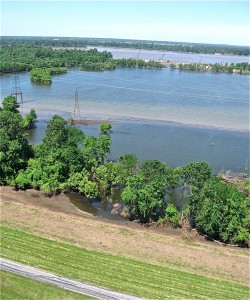
By CARL GREEN
Illinois Correspondent
Collinsville – A Mississippi River levee project estimated to cost up to $20 million will be completed locally using local union labor.
The Southwestern Illinois Flood Prevention District Council voted unanimously Nov. 20 to reject a construction agreement with the U.S. Army Corps of Engineers – which has consistently refused to accept a Project Labor Agreement (PLA) for the work – and take over the project itself on grounds that it can save money while assuring the local workforce is used.
The vote upheld the Council’s policy of using PLAs, which assure contractors an adequate and prepared labor force while ensuring workers are hired locally.
The Council will forego about $13 million in federal money by taking over the project, leaving it to be financed entirely by a quarter-cent sales tax Metro East voters approved in 2008 for flood control improvements. The tax generates about $11 million a year from Madison, St. Clair and Monroe counties.
The project comes at a time when work has been scarce for much of the union labor force.

“It’s going to help us out,” said Dale Stewart, executive secretary-treasurer for the Southwestern Illinois Building and Construction Trades Council, the group that administers PLA here. “We’re really thankful. That was a tough vote for the board to take, but it was the right thing to do.”
The project, a cutoff wall, is a major part of a larger series of levee improvements being overseen by the Council, in partnership with the Corps of Engineers, to protect the Metro East from flooding on the Mississippi River.
PROTECTING INDUSTRY
The 1,800-foot-long wall will be built adjacent to where Wood River Creek enters the Mississippi east of Mel Price Lock and Dam. River water has been seeping through in the area, endangering the levee, which protects a vital industrial area. The wall will be built down to the bedrock, providing protection from the seepage.
The project also includes a shallower but longer 1,900-foot wall, which will be built west of the dam, near the city of Alton.
COMMITMENT TO WORKFORCE
The Corps of Engineers estimated the project cost at $20 million and has been preparing the design for the walls. If the Corps were to complete the work, the local share from the Council would amount to about 35 percent of the cost. However, the consistent refusal of the Corps to accept a PLA for the project left open the possibility of a contractor bringing in non-union labor from out of town.

Les Sterman, chief supervisor of construction for the Council, said that would been an unacceptable use of the local sales tax, which was promoted on the grounds that local workers would be employed, keeping the money circulating in the community.
“We felt like it was important to keep our commitment to the local workforce,” Sterman said, noting that the nine-member board is bipartisan and the vote was unanimous.
Stewart said the decision validates the effort made by labor and political leaders to get the sales tax approved. “Those dollars turn over seven times in the local economy,” he said.
PARTNERS
Corps officials made a presentation at the Council meeting as well but were unable to convince the board that the Corps should remain in charge of construction. The Corps will, however, remain involved in the design of the improvements.
Sterman is hopeful the job can be completed by the end of 2015.
“The fact is we’re partners on the project,” he noted. “The Corps designed it, we’re going to build it.”
The entire levee improvement project is expected to cost more than $100 million.
By the time the work is done, Sterman said, the Council’s own cost savings will more than make up for the additional amount it must spend now on the cutoff walls.
MORE WORK TO DO
The Corps has another big job to do on that section of the river – correcting under-seepage resulting from construction of the Mel Price dam itself. That job will require no local money because it is a result of the government building the dam, which was completed in 1994.
The dam’s purpose is to keep the river open to barge and other maritime traffic by creating a navigable pool upstream, making the river level lower below the dam, which puts additional pressure on the levee, resulting in more under-seepage.
Sterman said the problem can be seen in periodic flooding along the north side of Illinois Highway 143, known as the Berm Highway, during periods of high water to the east of the dam.

